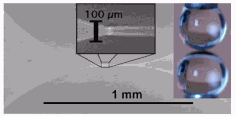It happens every time it rains, every time you cry, in fact trillions of times a day in endless variations. You can watch it happening on your car windshield, through a window, or down the side of an ice-cold glass of lemonade on a summer day. Two drops of liquid, at first separate and distinct, meet and come together to form a bigger drop. It’s one of the most common physical phenomena on Earth, and yet we still do not know exactly how it happens, because it occurs so quickly, and because seeing the meeting point—the interface between the two drops—is problematic. But scientists from Argonne National Laboratory, using the XOR 32-ID-B,C beamline at the Argonne Advanced Photon Source (APS), have found a window into the process of water drop coalescence, employing ultrafast pulses of full-spectrum, high-intensity x-rays to capture with unprecedented clarity and definition the moment of two water droplets becoming one, as detailed in their study published in Physical Review Letters.
The problem of coalescence between two drops of liquid has generated a great deal of theoretical work and speculation that has been difficult to support by actual experiment. “We were interested in this particular problem because there are discrepancies in the literature about the initial contact between two drops: just when does it really start?” said Kamel Fezzaa, one of the Argonne researchers in this study. “With visible light you have a very awkward viewing angle for this type of phenomena because of shadowing and refraction.” But the greatly enhanced resolution and penetrating power of the ultrafast white x-ray pulse from the APS offered a way to settle some of the arguments.
In the experiment, two syringes in precise alignment, one above the other, were connected to a water tank located slightly above the merging plane, so that one droplet from above and one from below would be brought together by a natural siphoning effect. The water was made slightly saline to enhance its electrical conductivity, to complete a circuit upon droplet coalescence and thus serve to trigger the high-speed charge-coupled device camera that captured the merging of the drops. With the camera synchronized in various ways to an x-ray pulse with a duration of 472 nanoseconds, a series of stroboscopic images of the coalescence event could be obtained. Using this technique, the experimenters could resolve details as tiny as 5 microns.
That 5-micron resolution is important, as it turns out to be the smallest height of the liquid bridge between the water drops that could be seen during the experiment. As the drops continue to merge and the bridge between them increases in size, a toroidal bubble of trapped air temporarily forms. “We can see this bubble, or bulging, inside the bridge between the two drops,” said Fezzaa. “It was actually predicted with some models, but has never been seen. In some papers they thought there was a 90-degree angle in this bridge, whereas really it was just bulging inside and coming back, and one had the illusion in the visible light that there’s a 90-degree angle.”
Both the formation of the bubble and the bridge—or meniscus—between the coalescing drops follow a power law scaling just as predicted by theory. Still elusive is what happens at “time zero,” i.e., the precise moment of first contact between the two drops. “There are scaling laws and different power laws for this that are slightly different depending on when one sets the zero time,” Fezzaa said. “In our case, we went back to about 5 microseconds closer to the actual time zero. But still, what really happens at time zero is beyond our experimental technique.” Peering into that “time zero” realm may be possible with other indirect approaches or the use of even faster x-ray pulses in the sub-nanosecond range with a higher spatial resolution, which Fezzaa considers a “most exciting prospect.”
For now, though, the researchers have demonstrated how very bright, very short x-ray pulses can capture extremely fast phenomena that can’t be seen with other methods. They’ve already used the technique to study the formation and breakup of a jet of liquid from a nozzle. Fezzaa observes, “We can use it to probe things that move at hundreds of meters per second. That’s enough for most of the fluids we know. The next step is to apply it for things that move even faster.” Possibilities include the practical study of fuel-spray dynamics, flow singularities, the propagation of microscopic cracks in metals and other solids, and ballistic or explosive phenomena.
Still, even with this new ability to study what physicists call a hydrodynamic singularity, the essential, simple beauty of what our eyes see in visible light—two water drops joining together—remains unchanged. — Mark Wolverton
Contact: *[email protected], †[email protected]
See: Kamel Fezzaa† and Yujie Wang*, “Ultrafast X-Ray Phase-Contrast Imaging of the Initial Coalescence Phase of Two Water Droplets," Phys. Rev. Lett. 100, 104501 (2008). DOI: 10.1103/PhysRevLett.100.104501
Use of the APS was supported by the U. S. Department of Energy, Office of Science, Office of Basic Energy Sciences, under Contract No. DE-AC02-06CH11357 and Argonne National Laboratory Director’s Competitive Grant (LDRD) No. 2006-023-R1.
Argonne National Laboratory brings the world's brightest scientists and engineers together to find exciting and creative new solutions to pressing national problems in science and technology. The nation's first national laboratory, Argonne conducts leading-edge basic and applied scientific research in virtually every scientific discipline. Argonne researchers work closely with researchers from hundreds of companies, universities, and federal, state and municipal agencies to help them solve their specific problems, advance America 's scientific leadership and prepare the nation for a better future. With employees from more than 60 nations, Argonne is managed by UChicago Argonne, LLC for the U.S. Department of Energy's Office of Science.

